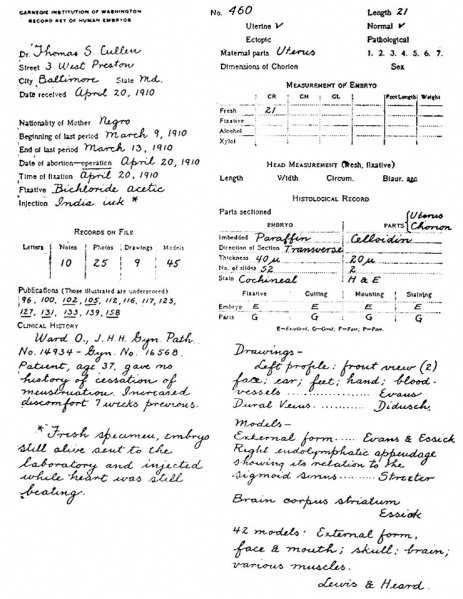File:Mall Meyer1921 fig01.jpg

Original file (740 × 958 pixels, file size: 151 KB, MIME type: image/jpeg)
Fig. 1. Specimen page from "Key," showing manner in which records of embryos are entered
When the collection was taken over by the Carnegie Institution of Washington it was found necessary to open a book in which are recorded all data relating to specimens, a page being devoted to each. As these volumes have proved to be of great value in keeping track of the collection, we have designated them as the Key. A specimen page of the Key, which records embryo No. 460, is reproduced in figure 1. The data collected are entered in the first column. Only the number of letters received and the number of photographs made are recorded here, this being sufficient to show any interested person what may be found in the permanent file. In the latter, each note is stamped with the catalogue number of the specimen and the date of filing, so that notes entered in successive years can easily be arranged in sequence. In the upper part of the second column of figure 1 are recorded the dimensions and general character of the specimen, which, of course, necessitates a general classification, for at this time it must be determined whether or not the embryo is normal or pathological. Since the diagnosis is made entirely upon its general appearance and form, it does not follow, when an embryo is classified as normal, that it necessarily is so, but only that it is normal in form. This point will be discussed later.
| Embryology - 19 Apr 2024 |
|---|
| Google Translate - select your language from the list shown below (this will open a new external page) |
|
العربية | català | 中文 | 中國傳統的 | français | Deutsche | עִברִית | हिंदी | bahasa Indonesia | italiano | 日本語 | 한국어 | မြန်မာ | Pilipino | Polskie | português | ਪੰਜਾਬੀ ਦੇ | Română | русский | Español | Swahili | Svensk | ไทย | Türkçe | اردو | ייִדיש | Tiếng Việt These external translations are automated and may not be accurate. (More? About Translations) |
Mall FP. and Meyer AW. Studies on abortuses: a survey of pathologic ova in the Carnegie Embryological Collection. (1921) Contrib. Embryol., Carnegie Inst. Wash. Publ. 275, 12: 1-364.
- In this historic 1921 pathology paper, figures and plates of abnormal embryos are not suitable for young students.
1921 Carnegie Collection - Abnormal: Preface | 1 Collection origin | 2 Care and utilization | 3 Classification | 4 Pathologic analysis | 5 Size | 6 Sex incidence | 7 Localized anomalies | 8 Hydatiform uterine | 9 Hydatiform tubal | Chapter 10 Alleged superfetation | 11 Ovarian Pregnancy | 12 Lysis and resorption | 13 Postmortem intrauterine | 14 Hofbauer cells | 15 Villi | 16 Villous nodules | 17 Syphilitic changes | 18 Aspects | Bibliography | Figures | Contribution No.56 | Contributions Series | Embryology History
| Historic Disclaimer - information about historic embryology pages |
|---|
| Pages where the terms "Historic" (textbooks, papers, people, recommendations) appear on this site, and sections within pages where this disclaimer appears, indicate that the content and scientific understanding are specific to the time of publication. This means that while some scientific descriptions are still accurate, the terminology and interpretation of the developmental mechanisms reflect the understanding at the time of original publication and those of the preceding periods, these terms, interpretations and recommendations may not reflect our current scientific understanding. (More? Embryology History | Historic Embryology Papers) |
File history
Click on a date/time to view the file as it appeared at that time.
| Date/Time | Thumbnail | Dimensions | User | Comment | |
|---|---|---|---|---|---|
| current | 21:47, 29 March 2017 |  | 740 × 958 (151 KB) | Z8600021 (talk | contribs) | |
| 23:31, 19 November 2012 |  | 800 × 1,000 (154 KB) | Z8600021 (talk | contribs) | ==Fig. 1. Specimen page from "Key," showing manner in which records of embryos are entered== {{Carnegie56 TOC}} |
You cannot overwrite this file.
File usage
The following 2 pages use this file:
